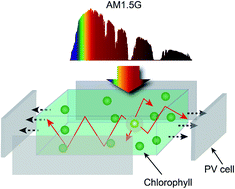Sustainable luminescent solar concentrators based on organic–inorganic hybrids modified with chlorophyll†
Abstract
Luminescent solar concentrators (LSCs) are luminescent waveguide layers that convert sunlight into specific wavelengths which are then guided by total internal reflection to a PV device located at the edges of the LSC. Their ability to concentrate sunlight onto small areas makes LSCs a useful complement to silicon-based PVs in a series of applications, such as urban integration and flexible fabrics towards mobile solar-energy. Challenges for the luminescent layer include the use of low-cost and sustainable nature-based organic molecules. We report novel chlorophyll-based LSCs with emission properties in the red/NIR spectral region. Here, chlorophyll molecules extracted from Spirulina maxima, an abundant cyanobacterium and an attractive natural source, are immobilized in organic–inorganic di- and tri-ureasil matrices enabling the production of sustainable LSCs. At low chlorophyll concentrations (<3 × 1017 molecules per cm3), the photophysical properties of the chlorophyll molecules after incorporation into the hybrids closely resemble those in ethanolic solution (with an absolute emission quantum yield of ∼0.16 and a fluorescence lifetime of ∼8 ns). The LSCs were coupled to a Si-based commercial PV device revealing optical conversion efficiency and power conversion efficiency values of ∼3.70% and 0.10%, respectively, illustrating the potential of this approach for the development of nature-based LSCs meeting the requirements of reliable, sustainable and competitive energy systems.



 Please wait while we load your content...
Please wait while we load your content...